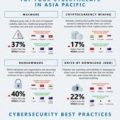Cybersecurity has become very common these days. These threats are malicious attacks that seek to access data, damage information, or disrupt digital operations unlawfully. It can originate from different actors such as disgruntled employees, lone hackers, criminal organizations, hostile nation-states, terrorist groups, hacktivists, and corporate spies.
Types of Security Threats
Below are some of the most common IT security threats that can harm your business,
- Malware – This is malicious software like worms, viruses, ransomware, and spyware. It is activated when a user clicks a malicious attachment or link that results in installing harmful software. Once the malware is activated, it can block access to different key network components, disrupt individual parts, make the system inoperable, covertly obtain information through the transformation of data from hardware, and install extra harmful software.
- Password Attacks – A cyber attacker with the correct password has access to a lot of information. The different types of password attacks include social engineering, outright guessing, and accessing password databases.
- Phishing Attacks – This is a form of information security threat that breaks regular security practices and gives up confidential information such as credit card information, Social Security numbers, login credentials, address, names, and other forms of financial information. Hackers, in most cases, send fake emails that appear legitimate.
In these attacks, hackers try to get users to take some recommended action like clicking on a link provided in the email, which directs them to a fraudulent site that asks them to install malware or ask for personal information. Opening attachments mentioned in the email may also install the malware on the user’s device that is designed in harvesting sensitive information, sending emails to contacts, or offering remote access to devices.
- Rootkit – This is a standard malicious program that installs and executes a malicious code on systems sans the user’s consent to gain administrator-level access to either a network system or a computer. Rootkit Virus is of different types- application rootkits, kernel-level rootkits, firmware rootkits, and bootkits. This virus can be infected on a PC either by sharing drives or disks that are infected. Typically, it gets installed with a password that is stolen or via exploiting system vulnerabilities, phishing techniques, and social engineering tactics without the victim’s knowledge.
- APT Threats – APT or advanced persistent threats are cyber-attacks that call an unauthorized attacker to code their way to unsuspecting system networks that stay undetected for some time. Rather than revealing its position, it siphons financial information and other sensitive security information from the network of the victim. Advanced persistent threat architects are adept at using numerous methods for gaining network access, utilizing malware, exploiting kits, and other sophisticated ways to do so. After obtaining the credentials, this attacker will dive into the network to infect the systems’ remaining parts, compromising the maximum data possible.
If your company needs additional help to keep the network free from such security threats, the bottom line is to contact an expert for a consultation.






